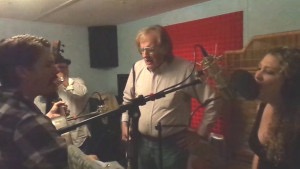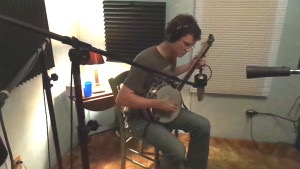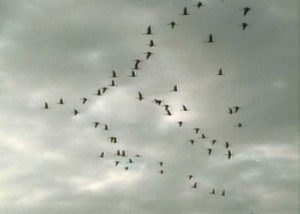Listen and Watch song samples from the new “Tribute” CD below: The newest video just added is, “Lost Tourist’s Letter Home.”

(To order a CD, please send $15.00 to: Jessie Townsend,
13501 SE 171st Lane Hawthorne, FL 32640)

Jessie and Lee Townsend recently went back into the studio to record six more songs to add to their CD Sampler. The CD will now have 12 songs and be titled, “Tribute” as it will have songs from several of Florida’s best songwriters past and present including Will McLean, Steve Blackwell, Jim Ballew, Dale Crider, Don Grooms and Ann Thomas to name a few.

Below you will find music videos of six of the songs included on the project followed by audio samples from all of the songs on the CD including “Lost Tourist’s Letter Home,” written by the late Ann Thomas about a tourist travelling by bus from Boston who was headed to Miami, but got off in the Florida scrub by mistake; “Crying Bird,” written by the late Will McLean about the potential demise of the Florida Limpkin; “Lonesome Wind Blues,” written by the late Wayne Raney and made popular by the Father of Bluegrass, Bill Monroe; “When I Die” written by the late Jim Ballew; “Oh Kissimmee River” written by environmental troubadour Dale Crider from Windsor, FL and “Wild Birds” written by the late Don Grooms.
Jessie and Lee were joined in the studio for this CD by Chris Henry (guitar, mandolin and vocal harmony), Red Henry (fiddle, mandolin and vocal harmony), David McBrady (bass and vocal harmony), Jason Thomas (mandolin). Gabe Valla (rhythm guitar), Christian Ward (fiddle), Elisabeth Williamson (vocal harmony) and Lon Williamson (bass). The lost tourist in the first video, “Lost Tourist’s Letter Home,” is portrayed by Harriett Meyer.
Lost Tourist’s Letter Home
Crying Bird
Lonesome Wind Blues
When I Die
Wild Birds
Oh Kissimmee River
Song samples:

Kentucky Borderline (written by Rhonda Vincent and Terry Herd) Performing on this fast-paced bluegrass tune that was the 2004 IBMA Song of the Year are Lee on banjo, Jessie singing the lead vocal, Jason Thomas on mandolin, Gabe Valla on rhythm guitar, Christian Ward on fiddle, David McBrady on bass and Elisabeth Williamson singing vocal harmony.
Bury Me Beneath The Willow This traditional bluegrass song features Jessie singing the lead vocal, Lee on guitar and David McBrady on bass and vocal harmony.
Nails In My Coffin (written by Gerald Irby) This song orginally written in 1946 features Lee on banjo and rhythm guitar, Jessie singing lead vocal, Elisabeth Williamson on vocal harmony, Christian Ward on fiddle and David McBrady on bass and vocal harmony.
If I Needed You (written by Townes Van Zandt) features Jessie singing the lead vocal, Lee on guitar, Christian Ward on fiddle, David McBrady on bass and Elisabeth Williamson and David McBrady on vocal harmony.

Macclenny Farewell (written by Will McLean) This love song written by the late Father of Florida Folk features Jessie on the lead vocal, Lee on guitar and David McBrady on bass.
 The Line (written by Steve Blackwell) The line was written by the late Steve Blackwell from Punta Gorda who penned this beautiful song about someone reflecting on all of the family members who have gone on before. This rendition of the song features Jessie singing the lead vocal, Lee on guitar and Lon Williamson on bass.
The Line (written by Steve Blackwell) The line was written by the late Steve Blackwell from Punta Gorda who penned this beautiful song about someone reflecting on all of the family members who have gone on before. This rendition of the song features Jessie singing the lead vocal, Lee on guitar and Lon Williamson on bass.
Oh Kissimmee River (written by Dale Crider) Oh Kissimmee River written by environmental troubadour from Windsor, FL, Dale Crider, brings attention to the disastrous environmental effects of trying to straighten the Kissimmee River. This version features Jessie singing the lead vocal, Lee on banjo, Chris Henry on guitar, Red Henry on mandolin and David McBrady on bass.

When I Die (written by Jim Ballew) When I Die is one of the most beautiful songs ever written by the late Jim Ballew. It features Jessie on vocals, Lee on guitar, Chris Henry on mandolin, Red Henry on fiddle and David McBrady on bass.

Cryin’ Bird (written by Will McLean) Cryin’ Bird by Will McLean brings attention to the potential extinction of Florida’s Limpkin because of the lack of food resources the Limpkin eats in the Wakulla River. Jessie sings vocal, Lee plays guitar, Chris Henry plays mandolin, Red Henry is on the fiddle and David McBrady is on bass. Elisabeth Williamson adds vocal harmony.
Lonesome Wind Blues (written by Wayne Raney) Lonesome Wind Blues is a very traditional bluegrass song. It was originally recorded in 1947 by Wayne Raney and later made famous by the Father of Bluegrass Bill Monroe. In this version Jessie sings the vocals with harmony added by Chris and Red Henry. Lee plays banjo, Chris Henry plays guitar, Red Henry is on the mandolin and David McBrady is on the bass.
Wild Birds (written by Don Grooms) Wild Birds is a love song written by the late Don Grooms. Jessie sings the vocals, Lee is on guitar, Chris Henry is on mandolin, Red Henry is on fiddle and David McBrady is on bass.
Lost Tourist’s Letter Home (written by Ann Thomas) In this tongue-in-cheek song the late Ann Thomas pokes fun at what a lost tourist would write home about if he or she got off a tour bus in the middle of Florida. Jessie sings vocals, Lee plays banjo, Chris Henry is on guitar, Red Henry is on mandolin and David McBrady is on bass
Jessie and Lee have been performing for several years. Venues have included the Florida Folk Festival, the Will McLean Festival, the Alachua and Micanopy Festivals, bluegrass events in Waldo, the Christmas Candelight program at Disney World and a variety of other church services and community events.
To order a CD, please send $15.00 to:
Jessie Townsend
13501 SE 171st Lane
Hawthorne, FL 32640
To book Jessie and Lee for musical performances call 352-575-3042, or send an email to townsendjessie@gmail.com.
















